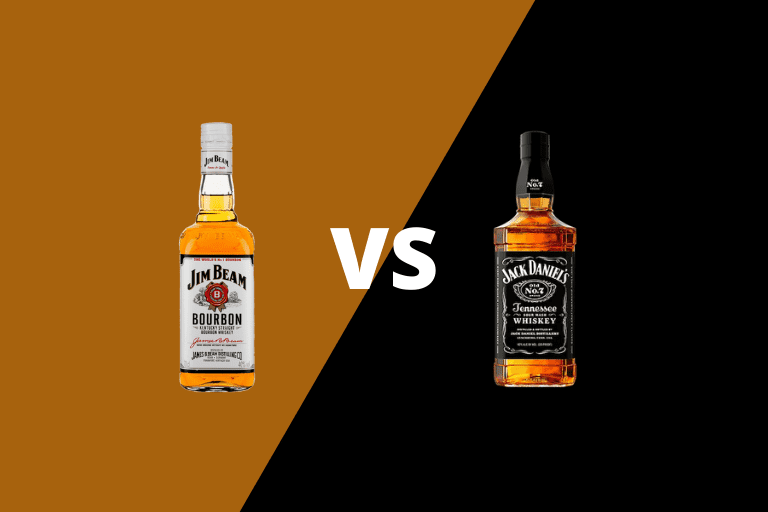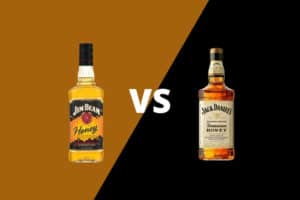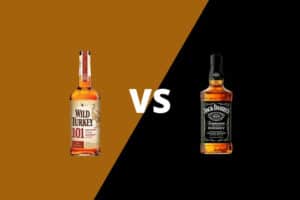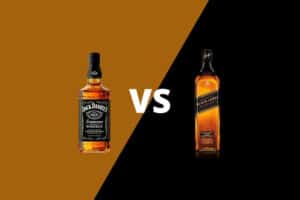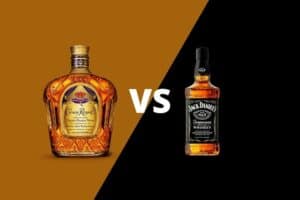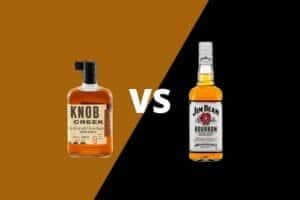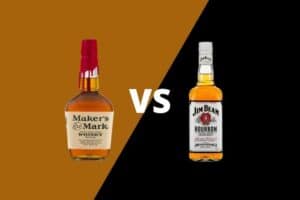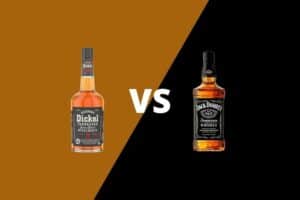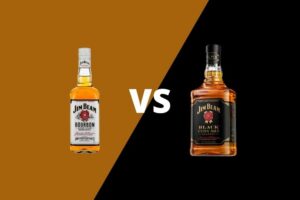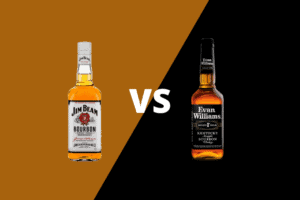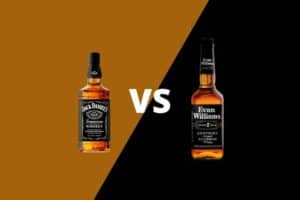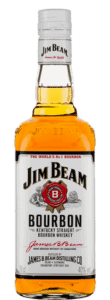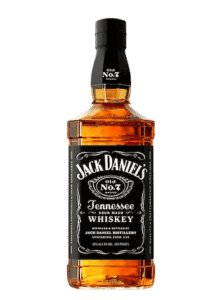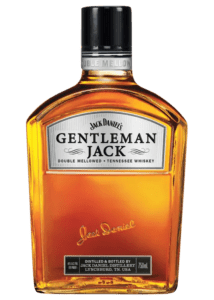Grab your popcorn and a comfy seat and get ready for the battle of a lifetime — one that has been centuries in the making.
Jim Beam vs. Jack Daniel’s: There are no bigger names when it comes to American whiskey.
It is a showdown between the two bestselling American whiskeys on the marketplace that pits Kentucky bourbon against Tennessee whiskey.
Together, they act as global ambassadors for a uniquely American style of whiskey making. But each brand has its own style that makes their products truly one-of-a-kind.
Table of Contents
History
These two brands help tell the story of the evolution of America’s unique whiskey-making style and the sweet corn-forward flavor associated with it.
Both Jim Beam and Jack Daniel’s are named after actual historical characters. Each helped pioneer a national style of whiskey-making that is recognized around the globe.
Jim Beam’s Origin Story
In 1778, Jacob Beam moved to the territory of Kentucky. He was part of a westward migration of settlers who brought the frontier’s whiskey-making traditions with them.
Settlers in Western Pennsylvania had been making whiskey from surplus grain since people of European descent first arrived in the early 18th century. Kentucky settlers continued this tradition but with a twist. To promote westward expansion and food security, federal policy incentivized the production of corn. So, while earlier whiskey producers in the mountainous Ohio Valley region fermented their hearty rye grain crops, Kentucky distillers began using corn for a distillate that retained some of the sweetness from the grain.
Using this backdrop, we return to the Beam family, who began making whiskey in 1795. The brand’s namesake — Colonel James’ Jim’ Beam — was a fifth-generation distiller who took over the family operations in 1894.
Jack Daniel’s Origin Story
Jack Daniel was also an actual historical figure, and he was a contemporary of Jim Beam. And — as with many historical figures — the life he lived reflected the times.
Jack Daniel learned the art of distilling from a slave when he was a young boy growing up in the Antebellum South. His teacher’s name was Nearest Green, and he invented a technique that filtered newmake spirit through sugar maple charcoal. This would eventually become known as the Lincoln County process, and it is what makes Tennessee whiskey unique in the world of distilled spirits.
After the war, Jack Daniel — now a young man — founded a new distillery in Moore County, Tennessee, in 1875. And Nearest Green — now a freedman — came to work for him as his head distiller.
Before modern distillation techniques, Jack Daniel and Nearest Green created a whiskey that used innovations like the Lincoln County and sour batch processes to create a more refined product than competitors, consistent from batch to batch.
Post-Prohibition
The narrative of nearly all American whiskey brands has a jarring disruption during the early 20th century thanks to Prohibition.
From 1920 to 1933, the sale of all alcoholic beverages was outlawed in the United States. Both the Jim Beam and Jack Daniel’s distilleries — like most alcohol production facilities in the nation — were shut down during this period.
But for both brands, it was during the post-Prohibition boom that they earned their international prominence.
After Prohibition ended, both distilleries roared back to life. Jack Daniel’s earned a huge push when it was purchased by spirits producer Brown-Forman in 1956. Under that company’s leadership, the brand’s Old No. 7 black label could be found in bars across the country.
Jim Beam was also happy to oblige a thirsty population after Prohibition ended. The distillery cranked out bourbon at an incredible pace to meet market demand during the post-WWII years.
During the late 70s and 80s, consumer tastes shifted to unaged spirits, primarily vodka and gin. During this time, sixth-generation distiller Booker Noe — the grandson of Jim Beam — helped elevate the bourbon category by introducing high-end whiskeys, including Booker’s and Knob Creek brands.
Mashbill
Jack Daniel’s and Jim Beam have similar mash bills, the list of grain ingredients used during fermentation to produce alcohol.
Both brands contain three-quarters or more percent corn, with rye and malted barley rounding out the grain list. There are subtle disparities — Jack uses a little more corn, and Beam uses a little more rye. Although relatively small, these variables make a noticeable difference when tasting both the clear or ‘white’ newmake spirit off the still, or the finished product after maturation.
By using more corn in the mashbill, Jack Daniel’s retains some of the corn sweetness in its whiskey. By using a higher rye percentage, Jim Beam contains some spicy character from the rye grain.
Jack Daniel’s is also a sour mash whiskey. This describes the process in which whiskey makers use a portion of a former, terminal mash to use as a starter for the next mash being fermented. This acts as a pH and alkalinity check for the new mash and creates an opportunity for ambient yeast and lactic acids to contribute to the fermentation process. These agents can create compounds whose flavors are often described as sour.
Longtime Jim Beam fans might remember a time when the term ‘Sour Mash’ was used on the Jim Beam label. The label no longer carries that term.
During the fermentation process, yeasts consume the digestible sugars in the mash and produce ethyl alcohol and carbon dioxide.
Distillation & Production
After the fermentation process has been completed, whiskey makers are left with a type of beer with an alcohol percentage of about six percent. Next, they must separate the alcohol from the rest of the liquid in a process called distillation.
Distillation is made possible by the difference in the boiling temperatures of alcohol and water. Because alcohol boils at a lower temperature than water, distillers can collect alcohol vapors and condense them into high-proof spirits.
Both Jack Daniel’s and Jim Beam use continuous distillation in the production of their whiskeys.
Modern column stills use a series of metal plates to separate alcohol vapor from the liquid mash. These column plates allow the spirit to continuously vaporize and recondense as they pass over the plates, with concentrated vapors rising and separating themselves from water and other liquids as they move their way downward.
After the distillation process, producers are left with a clear newmake or white dog spirit that can be up to 150-proof, or 75 percent alcohol by volume. It will be diluted to 125-proof or below before being placed in new American charred oak barrels for maturation.
This is where the Lincoln County Process comes into play. Before being placed into the barrel to age, Jack Daniel’s and other Tennessee whiskeys run their newmake spirit through a layer of maple wood charcoal. As the spirit trickles through the charcoal’s carbon, fusel oils, congeners and other impurities are removed.
The matchup between Jack Daniel’s and Jim Beam offers an opportunity to explore production capacity.
Modern column distillation plants for brands of this size can contain huge column stills that rise for stories and hold as many as 40 or more plates.
The Jack Daniel Distillery in Lynchburg, Tennessee, is the largest facility in the United States. It actually doubles the capacity of any other American distillery. Jim Beam, however, uses at least two sites for its production – the Booker Noe Distillery in Boston, Kentucky, and the Jim Beam Distillery in Clermont. Those facilities are No. 3 and No. 6 in terms of volume capacity, respectively.
Maturation
After the distillation process, producers are left with a clear newmake or white dog spirit that can be up to 150-proof, or 75 percent ABV. The time spent in contact with wood enables the white spirit to mature into the amber or brown aged spirit commonly recognized as whiskey.
But before the spirit goes into the barrel, Jack Daniel’s and other Tennessee whiskeys undergo the Lincoln County process.
By law, both bourbons and Tennessee whiskeys must be aged in new American charred oak barrels. This requirement sets apart many American whiskeys made in the United States from their counterparts in other parts of the world. In fact, the secondary barrel market created by U.S. producers means most whiskeys produced in Scotland, Ireland, Canada, Japan and other well-known whiskey regions mature their spirit in used Bourbon and Tennessee whiskey barrels.
When spirit is placed in a barrel, it interacts with the porous wood surface. Coopers char the inside of the cask, creating a layer of charred carbon. When passing back and forth through the charcoal layer, the alcohol is exposed to a type of filtration. Interaction with the ‘red layer’ beneath the char builds complexity into the spirit by imbuing those flavors associated with fine-aged wine and spirits. These flavors include a compound known as vanillin, which is associated with the taste of vanilla, along with baking spice characteristics described as cinnamon and nutmeg. Over time, these flavors develop the deep and rich flavors associated with mature whiskey, often described as leather and tobacco.
The amount of time a spirit spends in the barrel is considered a mark of quality. An older age statement on a whiskey bottle lets the customer know how many years the spirit has been exposed to the wood barrel.
Jim Beam is a straight Bourbon whiskey, which means that it has been aged for at least two years in new American charred oak barrels. Jim Beam also carries an age statement of four years on its back label. This means each barrel used in the finished product has been matured for no less than four years.
Jack Daniel’s does not carry an age statement, and it is not a straight whiskey. So the customer does not know the minimum age of the spirit inside the bottle.
Line Up
Jim Beam
Jim Beam is owned by Beam Suntory, considered to be the third-largest producer of distilled spirits on the globe. It is based in Tokyo, Japan.
Over the years, Jim Beam has released many brand offshoots. Let’s take a look at the current stable of products available to today’s customer.
Jim Beam’ White Label’ Bourbon is a Kentucky Straight Bourbon Whiskey. It is considered Jim Beam’s Original and is the No. 1 selling bourbon offering in the world in terms of sales volume. It is bottled at 80-proof, or 40 percent ABV, and costs about $18.
Jim Beam Devil’s Cut is a brand extension that is a play on the term ‘Angel’s Share’ that describes the loss of spirit volume to evaporation during the aging process. Using a proprietary process, the production team extracts a portion of spirit that would otherwise be trapped in the barrel wood staves. About $24 for a 90-proof 750mL bottle.
Jim Beam Single Barrel is a single barrel bourbon and contains the liquid from one single barrel — often chosen by the master blender from a premium ‘sweet spot’ location within the maturation warehouse. Prices and proof may vary.
Jim Beam Black is a Kentucky Straight Bourbon Whiskey with additional time in the cask than the standard White Label offering and offers a trade-up opportunity for customers. It is bottled at 86-proof and costs about $24 for a 750mL bottle.
Jim Beam Double Oaked is a bottling in which already matured Jim Beam Bourbon is re-racked into new charred oak finishing barrels for an additional period of time. About $22 for a 750mL bottle at 86-proof.
Jim Beam Rye is a rye whiskey produced by the Jim Beam team. To be labeled a rye whiskey, the product must have at least 51 percent rye in the mashbill. It costs about $24 for a 750mL bottle at 90-proof.
Jim Beam Honey is a combination of Bourbon whiskey and honey liqueur. It is about $18 for a 750mL bottle.
Jim Beam Vanilla is a vanilla-flavored whiskey. It costs about $18 for a 65-proof 750mL bottle.
Jim Beam Apple is an apple-flavored whiskey bottled at 65-proof that costs about $18 for a 750mL bottle.
Jim Beam Fire is a spicy cinnamon liquor made with whiskey created to compete with the popular Fireball brand produced by the Sazerac company. It is bottled at 65-proof and costs about $18 for a 750mL bottle.
Red Stag by Jim Beam is a cherry-flavored whiskey. In many ways, it was an early predictor of how large the flavored whiskey category would grow. It also has numerous brand offshoots over the years.
Jack Daniel’s
Jack Daniel’s is owned by Brown-Forman, which is considered the largest American-owned spirits producer. It is a publicly held company based in Louisville, Kentucky.
Jack Daniel’s Old No. 7 Tennessee Whiskey is the brand’s standard black label offering. It is the No. 1 selling single brand offering of American whiskey in the world. It is bottled at 80-proof and costs about $24 for a 750mL bottle.
Jack Daniel’s Single Barrel is a lineup of single barrel expressions of Tennessee and rye whiskeys. A single barrel whiskey describes the bottling of one single barrel — often chosen by the master blender from a premium ‘sweet spot’ location within the maturation warehouse. Releases vary, but you can expect to pay about $44 for a 750mL bottle.
Gentleman Jack Double Mellowed Tennessee Whiskey is a premium extension product that uses charcoal mellowing both before entering and after the whiskey is dumped from the barrel. It costs about $34 for a 750mL bottle.
Jack Daniel’s Tennessee Rye is a rye whiskey produced by the Jack Daniel’s team. Rye whiskeys must contain at least 51 percent rye in the mashbill. A 90-proof 750mL bottle costs about $24.
Jack Daniel’s Tennessee Apple is an apple-flavored product made with Jack Daniel’s whiskey. A 70-proof 750mL bottle costs about $24.
Jack Daniel’s Tennessee Honey is a honey-flavored product made with Jack Daniel’s whiskey. It retails for about $24 for a 750mL bottle at 79-proof.
Jack Daniel’s Tennessee Fire is a cinnamon-flavored product made with Jack Daniel’s whiskey created to compete with the popular Fireball whiskey brand released by the Sazerac spirits company. Its suggested retail price is about $24 for a 750mL bottle at 70-proof.
Jack Daniel’s Sinatra Select is a brand extension that pays homage to the late singer Frank Sinatra. To make this Tennessee whiskey, coopers at Brown-Forman’s very own cooperage add proprietary grooves to the inside of the barrel staves, which they claim promotes maturation by increasing the surface area of the wood in contact with the spirit inside.
Jack Daniel’s Winter Jack is a blend of whiskey, apple cider liqueur and other flavorings.
The innovation teams for both brands stay busy. Each brand has a canned and bottled cocktail line in addition to high-volume ‘green label’ extensions, limited releases and other alcoholic and non-alcoholic beverages on the market. As a result, the full list of Jim Beam and Jack Daniel’s products is constantly changing.
Tasting Notes
Jack Daniel’s
Description: In the glass, Jack Daniel’s Tennessee Whiskey has a golden-amber color.
Nose: Oak and charcoal, with hints of pine and a buttery caramel aroma.
Palate: A spicy pepper flavor, with notes of clove.
Finish: Spicy with lingering pecan, black pepper and cherry.
[Related: Complete Jack Daniel’s Review]
Jim Beam
Description: In the glass, Jim Beam is burnt-amber in color.
Nose: Floral aromas with raisins, followed by notes of leather and tobacco.
Palate: Balanced new oak flavors with corn, chocolate, black pepper, tobacco and vanilla.
Finish: Sweet honey notes with vanilla and toasted almonds.
[Related: Complete Jim Beam Bourbon Review]
Verdict…
When comparing two of the largest-volume American whiskey brands on the global marketplace, a question as subjective as ‘Which tastes better?’ seems unfair. Even the most enthusiastic small Craft whiskey advocate would have to admit that to build the global name recognition these two brands enjoy, they must be doing something right.
Now that you know more about the two, you can decide yourself — are you a Jack person or a Beam person?
With these two brands, you won’t have trouble finding either product at your favorite whiskey bar or spirits shop. And their price points make it the perfect side-by-side tasting to start anyone looking to start their exploration of the American whiskey category.

